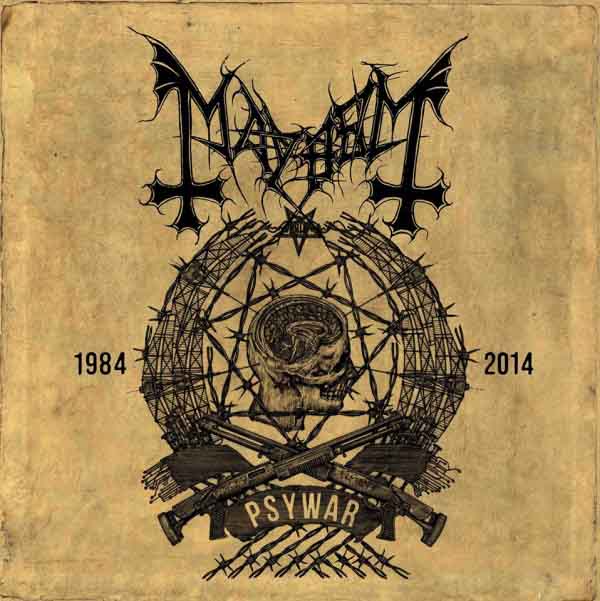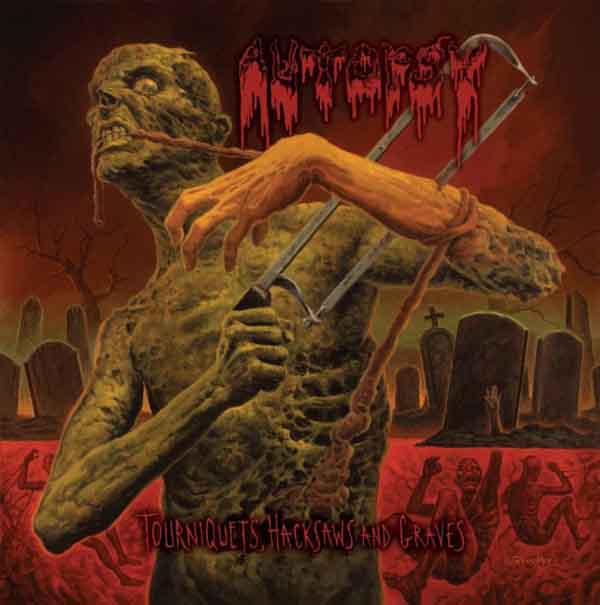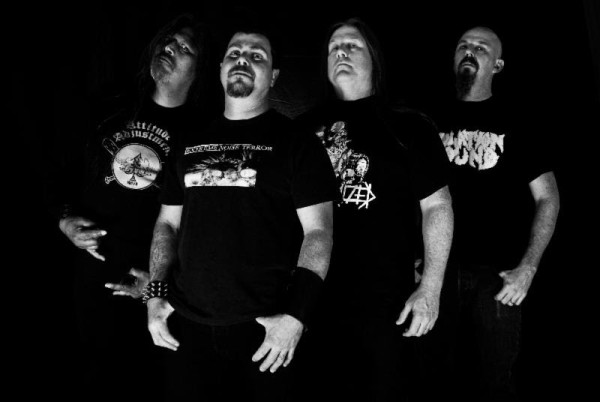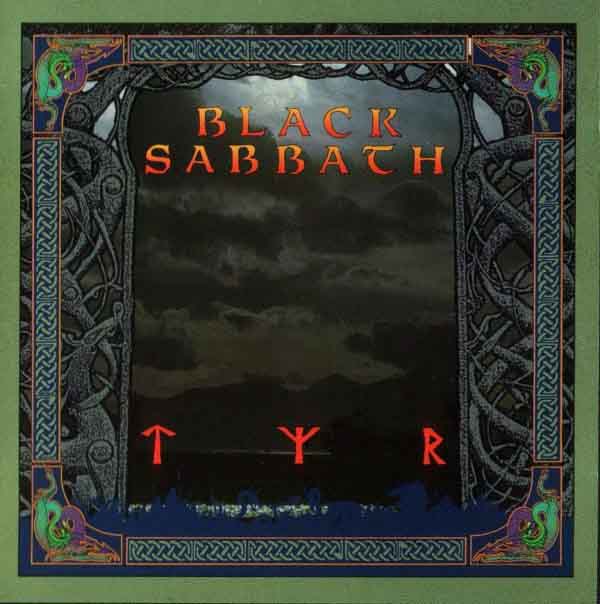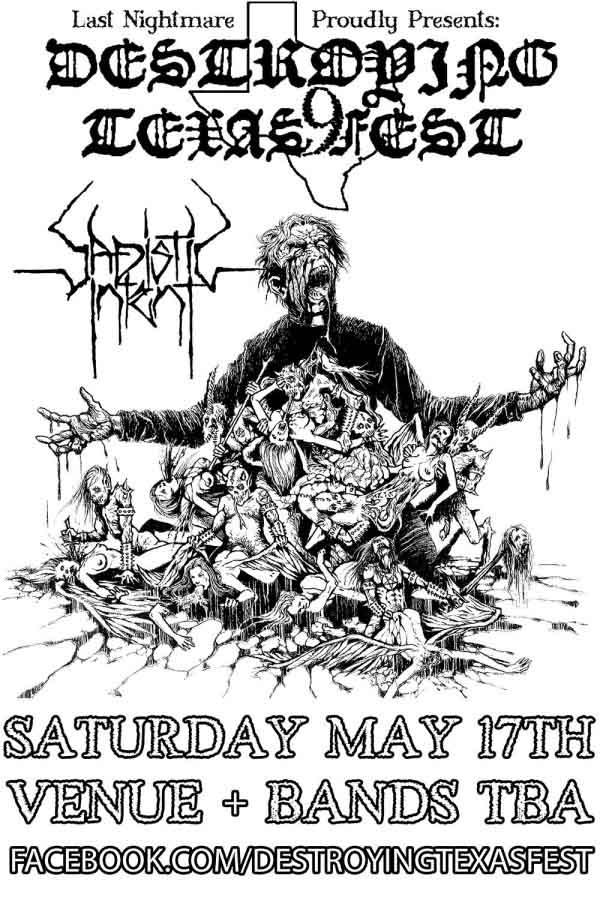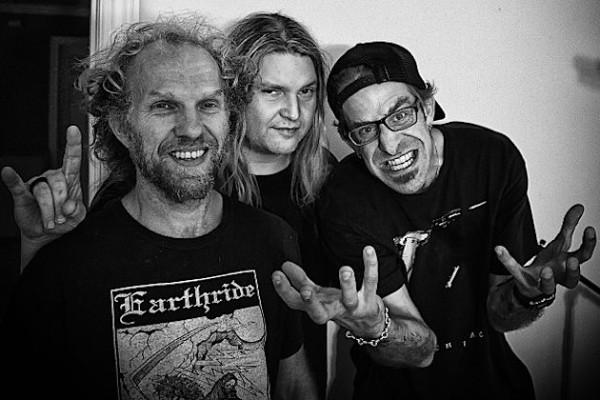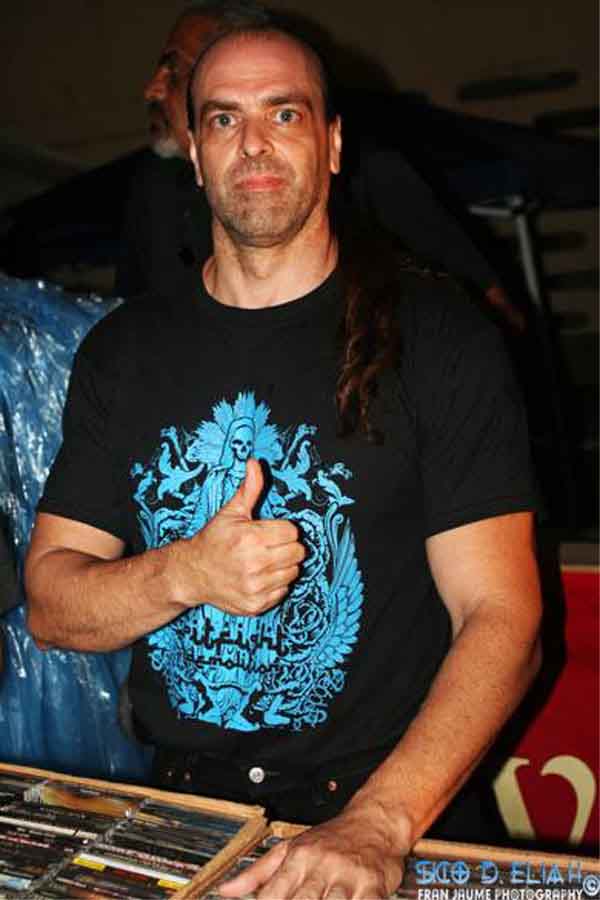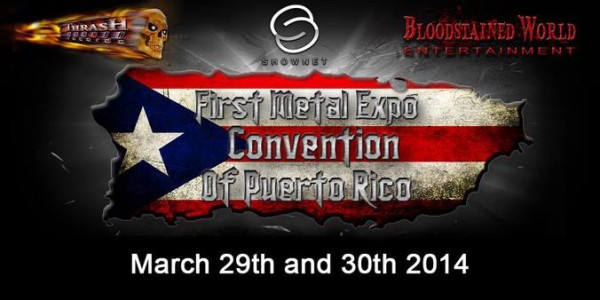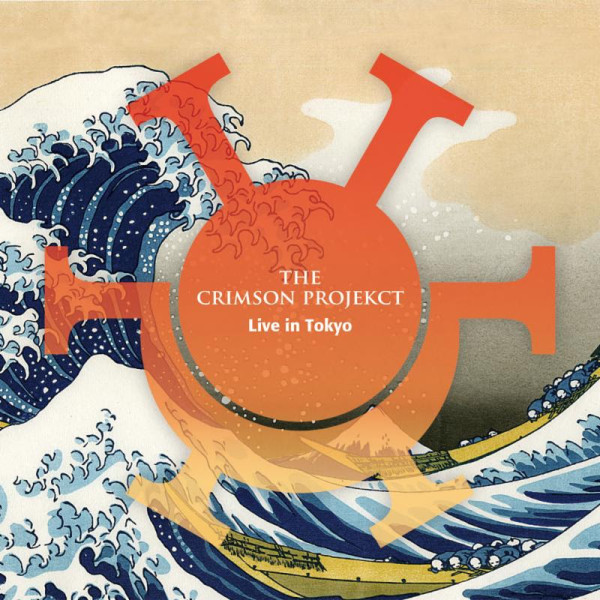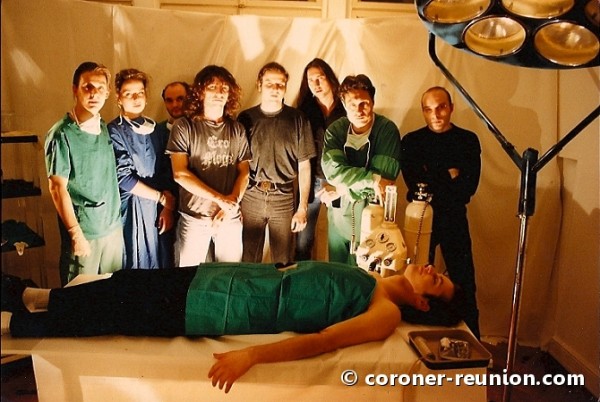Our staff is on vacation for the next two weeks, possibly longer. We’re re-assessing what we’re doing at the same time we’re sipping fancy cocktails on a beach somewhere, which suspiciously resembles our basements with a space heater and a poster of Florida. Our goal is to reach people with a message of DEATH METAL and it make take some re-assessment to make sure we’re going about that the right way.
20 CommentsMayhem – “Psywar”
Norwegian black metal band Mayhem have released the first side of their upcoming single, entitled “Psywar.” At 3.5 minutes it shows the band continuing their foray into modern extreme metal aesthetics.
The track starts out with palm-muted tremolo picking, which shares more with simplistic death metal than the band’s history of black metal. The verse begins with shouted vocals, with the guitar riff beginning to incorporate modern black metal’s ambiguous arpeggiated aesthetics; which then over-take the track in a short breakdown section, consisting of needling treble notes and “profound” whispered vocals. The track then goes back into action with rather standard modern black metal minor chord strumming, before a short homage back to basic death metal which concludes the track. In short, formulaic and predictable, though it is put together well and probably will garner the band financial reward.
Mayhem was noteworthy for its foundational role in shaping the Norwegian black metal scene. Although a few other bands may have had a more prodigious output, the role provided by the band in organizing the metal scene and the strength of its De Mysteriis Dom Sathanas album cemented the band’s legendary status.
For those who are intrigued by what’s presented on this single, but wish to hear the band in its former higher state, visit our Mayhem review archive here.
21 CommentsTags: Black Metal, mayhem, modern metal
Autopsy unleashes Tourniquets, Hacksaws and Graves on April 29
Old school swampy death metal band Autopsy continues its revival by pumping out another album of its newer incarnation of high-energy death metal, Tourniquets, Hacksaws and Graves, which will see release via Peaceville Records on April 29, 2014.
The seventh studio album from Autopsy will be right in line with its predecessors, with the band claiming that “blood will flow, brains will be destroyed, coffin lids will be opened…” Recorded at Fantasy Studios with producer Adam Munoz, the new album promises to sound and feel roughly like its two immediate predecessors, mixing rapid sawing riffs with slower, sludgy dirges.
Lineup
- Chris Reifert – drums/vocals
- Danny Coralles – guitar
- Eric Cutler – guitar
- Joe Trevisano – bass
Tags: autopsy, death metal, peaceville records
Black Sabbath – Tyr
If I ever have to declare a field of study — and I hope I never must — I will declare my intention to study transitional material. It is the most fascinating by far, and Black Sabbath Tyr demonstrates why.
Emerging in the final days of the 1980s and the first days of the new decade, Tyr shows Black Sabbath trying to keep one foot in what succeeded in the previous era while gesturing at inventing the next. The band is not bold enough to simply invent it, since they are too invested in being an industry in themselves. That puts them in the position of defending what they have by incorporating the current, not by redefining it and trying to become something new.
The 80s influences are most painful in the vocals, which bring back flashbacks to Miami Vice and War Games. The 1980s were above all a sentimental time: the late 60s had changed the nation, and now we were in the grips of a Cold War that threatened to eliminate us all in the absolute erasure of kill zone radius extermination. People sought emotion, a fleeting sense of beauty and hope in the night, before the coming darkness swallowed all. It was really a prolonged version of what Berlin must have been like in 1945, but no one could recognize it. They buried themselves in things: in work, in religion, in warfare or in ideology. And so the 1980s sound is that of the lover glimpsed on a passing train, a moment of hope in the doom, a taste of what could have been, drowned out in mechanical rumblings and coalescent submerging blackness.
While the elements of the proto-metal/prog fusion that Black Sabbath pioneered by adopting the longer phrase moveable melodies of modernist classical influenced Italian horror movie soundtracks are still present, the majority of the riffing on this album resembles 1970s hard rock emulating the electronic rhythms of 1980s pop. It’s not surprising that Ministry may have borrowed a few rhythm/riff-idea combinations from this album, given the raw creativity put into them and their mutual inspiration in the basis of 1980s “industrial” music through electronic body music (EBM). Black Sabbath balance the shorter, more mechanical hard rock riffs with their usual spanning chord progressions that give the sense of the camera pulling back to reveal a vista.
The result is highly melodic and merges with the vocals which sound like they’re right off a Mike & The Mechanics or Red7 record. The result neuters Sabbath to an uncomfortable degree because the focus is on vocals and synths and the guitar takes a rhythm role that supports those from the background. That has not stopped guitarist Tony Iommi from coming up with some rather odd and noisy variations on the riff that he uses to add uncertainty and a sense of being lost in a windswept plain to the otherwise more straightforward compositions.
Where Black Sabbath reach toward the future is in the layout of these songs and album. They are deliberately expanded structures with more variation between them, like scenes in a movie or different rooms in a house in a pursuit dream. This both reflects the influence of MTV and the increasingly technological nature of music which allowed radical changes in instrumentation, thus musicians could stick in entirely radical dynamic changes and have them work as more than a distraction. The album follows the same thought process, beginning with an acoustic introduction with semi-chanted vocals, as if invoking the Druids and giving the entire production a visual leadoff. The album itself moves like a conversation, starting with its most obvious big points and indulging in all the conventions of its decade, but then gradually bringing those back to roots and then expanding them with the final tracks, notably “Heaven in Black,” where hints of a more metal-oriented Sabbath emerge (especially in its recapitulation of the riff-idea for “Symptom of the Universe,” which as my colleague Martin Jacobsen writes, precapitulates the muted-strum technique used by all speed metal bands). Much of this anticipates the more epic conceptual and structural layout of both songs and albums that black metal and death metal would popularize; it is unclear whether Black Sabbath heard early prototypes of this notion, such as Bathory Blood Fire Death, but the similarities are great as they are to later Judas Priest like Sin After Sin and Iron Maiden’s epic 1980s material such as Seventh Son of a Seventh Son. Interesting also is the choice of Odinist thematic matter wrapped in Celtic imagery, as if questing for a new identity for metal that united its past with future.
Tyr shows Black Sabbath twenty years into their career. They are less innovators than standard-bearers and so their tendency is to absorb outside influences and translate them into heavy metal to give their genre relevance in the wider world. There are also other influences from within the metal world, such as a notable increase in Iron Maiden-styled galloping riffs and broader themes. As one reviewer once said, some albums are more interesting than good for listening to, and thus are more compelling to write about; Tyr may be too 1980s for me to listen to again, and I remember chucking it across the resale counter at a used CD shop over a decade ago for that reason. However, it shows us a nodal point for heavy metal in its evolution and anticipation of the next era.
http://www.youtube.com/watch?v=O0eOblstpng
6 CommentsTags: black sabbath, hard rock, Heavy Metal
Destroying Texas Fest IX to destroy Houston on May 17, 2014
Continuing the tradition of Texas shows that require the National Guard to calm down the audience afterward, Last Nightmare Productions presents Destroying Texas Fest VIII, featuring the following acts of pure power:
(more…)
Tags: blaspherian, concert, death metal, destroying texas fest, inverted trifixion, morgengrau, negative plane, nodens, sadistic intent
Teenage Time Killer readies debut LP
Occasionally, even the most cynical members of the DMU venture into the outside world to a realm where supergroups come together and convulse the media in marked excitement. Corrosion of Conformity members Mike Dean and Reed Mullin have put together a project entitled Teenage Time Killer, a 21-track album featuring many prominent names within the music industry.
Confirmed members via blabbermouth:
- Randy Blythe (LAMB OF GOD)
- Dave Grohl (FOO FIGHTERS)
- Corey Taylor (SLIPKNOT, STONE SOUR)
- Neil Fallon (CLUTCH)
- Jello Biafra (DEAD KENNEDYS)
- Lee Ving (FEAR)
- Tommy Victor (PRONG)
- Nick Oliveri (MONDO GENERATOR, ex-QUEENS OF THE STONE AGE, KYUSS)
- Aaron Beam (RED FANG)
- Pete Stahl (SCREAM, GOATSNAKE)
- Greg Anderson (SUNN O)))), GOATSNAKE)
- Karl Agell (ex-CORROSION OF CONFORMITY)
- Tairrie B. Murphy (MY RUIN)
- Mick Murphy (MY RUIN)
- Vic Bondi (ARTICLES OF FAITH)
- Clifford Dinsmore (BL’AST!)
- Pat Hoed (BRUJERIA)
Other guest musicians that were previously announced as taking part in the project:
- Max Cavalera (SOULFLY)
- Tony Foresta (MUNICIPAL WASTE, IRON REAGAN)
- Doyle Wolfgang Von Frankenstein (MISFITS)
- Keith Morris (BLACK FLAG)
- Phil Rind (SACRED REICH)
In a recent radio interview, Mullin stated that the project originally was conceived of as a short EP endeavor, but quickly grew to a larger album (seemingly) encompassing the earlier styles CoC has been affiliated with over its career, describing it as a mixture of “old hardcore punk, punk and metal stuff.”
Additionally, the band has revealed they have completed recording and are in the process of mixing their new album entitled Corinthians, which will be released via Candlelight. A release date has not yet been set for either record.
Corrosion of Conformity was best known for its foundational role in the 80’s scene, which along with Cryptic Slaughter and D.R.I created the genre of thrash, an organic fusion of punk and metal. Eventually, the band lost its sense of direction and started playing stoner rock for Scion AV festivals. Here’s to hoping the words about a return to the punk and metal days of the band represents an artistic change from their recent albums and is not simply a marketing ploy to intrigue older fans.
2 CommentsTags: alternative metal, corrosion of conformity, fear, prong, sacred reich, sepultura
Interview: Ray López of Thrash Corner Records
Regular DMU readers may have noticed that Puerto Rico has been on this site’s radar since Brett Stevens interviewed José “Chewy” Correa of Organic last year, and for good reason. The “Island of Enchantment” is more than just beaches, bikinis and piña coladas; it’s also home to one of the most active and diverse metal scenes that you’ve probably never heard of.
So what’s going on in this little-known metal outpost in the Caribbean? More and more international bands play here every year. Local bands are touring and inking deals overseas. There’s an online metal radio station broadcasting live shows every week. An international academic conference on heavy metal will be held at the University of Puerto Rico in March. We even have a biannual metal flea market where metaleros from all corners of the island gather to buy, sell and trade metal merch while local bands provide the live soundtrack. And this is only a short list; there’s a lot more happening here.
Cultural idiosyncrasies aside, all national and regional metal scenes are built with the same three human components: the bands, the fans and the people who have the initiative to organize and execute the business and logistics of the scene, otherwise known as “the people who make things happen.” These men and women of action don’t often get the recognition they deserve, yet they continue to work behind the scenes to bring your favorite bands to a venue near you. (Kreator didn’t play their first show in PR last year just because people “liked” their Facebook page; someone had to organize and execute a plan and all the logistics involved.)
Some of these men of action, such as Ray López of Thrash Corner Records, have also managed to actually make a living in the metal music world — not to mention help build and shape Puerto Rico’s metal scene — while balancing the responsibilities of a dedicated family man. (In fact, I didn’t know that Thrash Corner was his livelihood until I asked him what his day job was in a followup email.) So is he lucky that he’s living a “metalhead’s dream” or is it his work ethic that makes things happen?
Ray López was kind enough to take time from his busy schedule to answer some questions about his label, Puerto Rico’s metal scene and his most ambitious project to date, the first Metal Expo Convention of Puerto Rico.
You’ve been active in metal for over 20 years, so let’s start with your label, Thrash Corner Records. What motivated you to start your own label?
I’ve been a metalhead since 1980, and my label has 20+ years in business. The story is kind of weird. One day I just got up and said, “I’m tired of going to the store (never finding what I wanted) and ordering by mail (waiting sometimes up to two months to get my goodies).” An idea came to my mind. What if I call a distributor (those days it was Caroline Records and RED Distribution) and tell them that I opened a store and want to buy wholesale? So I just got the numbers and decided to call, and to my surprise they just opened an account for me and I started buying from those companies.
I said to myself, “that was very easy,” then another idea came to my mind. Let’s say I call Relapse Records, Century Media, Metal Blade and many others. Can they sell to me direct? But then I had to remind myself that I was in Puerto Rico and most of the people in the mainland don’t know the status of what we are. Most of them don’t know we are a territory of the US, so I took advantage of that and also started buying direct from them. Then I got deeper and deeper into the underground and saw how things were moving with the small labels (everything was about trading productions between each other), so I just jumped on the wagon and Thrash Corner Records was born.
What were some the most significant challenges in those first few years?
To be honest, everything was happening so fast that I was surprised with what I had accomplished in just the first year. If I have to mention something, the first thing that comes to my mind was trading with the other labels outside the US. Back then with no Internet, setting up a trade sometimes took up to 4 months (all the communication was via letters).
What are some of the highlights and gratifying milestones up to this point?
Those are many and I don’t want to bore you with that, so I will just mention a few:
Traveling to different places, meeting with bands, hanging out with them and sometimes becoming friends (the ultimate metalhead dream come true).
As a label, signing bands from other countries, getting distribution across the US and other countries (and that is more gratifying knowing that you were the first one to do that and in some cases the only one to accomplish that).
I understand that Thrash Corner has had distribution deals with US bands such as Hirax and Deceased. What are some of the other bands on your roster, and are there any upcoming releases we should be looking forward to?
Yes, Deceased released one album with us called As the Weird Travel On, considered by many an underground masterpiece. With Hirax there is a licensing deal and we did their complete catalog (the only title we don’t have will be the new one, SPV is the one releasing it). Now that Hirax signed with SPV, we feel very proud because we worked very hard with them as a team to get the attention they deserve and finally it pays. We also worked with both Asesino re-issues (Corridos de Muerte and Cristo Satánico). Those were out of print for many years, but now you can find them. Right now we are working with the death/thrash band from Florida, Solstice, doing our own version of the album The Dust (their 2009 full length). We decided to do that one because it had a limited distribution and we want all the fans to own this piece of art.
From our chat prior to this interview, I got an unequivocal impression that you’re a firm believer in the old saying: if you want something done right, do it yourself. Is Thrash Corner Records a one-man operation? If so, how important is it to have total control of your business and freedom to do things your way?
You are totally right: Thrash Corner Records is just one guy doing everything. It is hard work but it is worth it. You control everything and you make the decisions, right or wrong (no one to blame, just myself, but I can live with that, hahaha!!!).
I can say without conceit that I work in metal 100% and I’m the only one making a living from it here. It hasn’t been easy, but if you strive for your goals you can achieve them. My normal job is the label, selling retail and wholesale on eBay, my website and Amazon!!!
During that chat you also mentioned that you were born in the US and that English was your first language. How old were you, and were you a metal fan already when you moved to PR?
Yes, I was born in New York, but moved to PR when I was 5 years old. I wish a was metalhead at the time, but the concept of heavy metal was not invented yet, hahahaha!!
The good, the bad, and the ugly: Can you tell us what the overall situation was like for independent record distros, promoters and bands in PR back when you started Thrash Corner? How does it compare to the situation today?
Back in the old days of my label and distro, it was hard in some aspects and easy with others. Right now there are a few more distros and labels, but back then I was the only one. As for promoters, I was involved in 90% of the shows here, one way or the other. Now there are more promoters and they found the formula to do shows without my help. I don’t mean that in bad way, back then I had a lot of contacts because of the distro and the label and I was the only bridge that they had. Now with modern technology you can find bands with the click of a button. And about the bands, basically most of them are in the same situation now as they were back then (let me make a BIG NOTE: we had a few bands doing things the right way, but I can say we have more now than back in the days).
How did the idea for the Metal Expo come about? Did you formulate it and then presented a plan to people who could help you make it a reality, or did you discuss the idea and sketched it out over time with input from friends and associates?
I was crafting this idea for a while (let’s say the main concept is mine), but now that we have a team everybody is bringing ideas to the table!!! That’s why we had to change it to two days (in the beginning it was going to be a one-day event).
Was an event like the Metal Expo imaginable 20, 10 or even 5 years ago? What are the “pieces of the puzzle,” as you put it, that make this event possible today?
20 years ago – impossible.
10 years ago – maybe.
5 years ago – yes (but some pieces were missing).
About the pieces of the puzzle, I prefer to keep them to myself (this topic is too sensitive, so I prefer to make no comments)!!
There are quite a few underground metal promoters here in PR (some might say an unusually high number for such a small place). Why did you choose to join forces with your co-organizer, Paul Martínez of Bloodstained World Entertainment? Can you tell us a bit more about him?
For me this is the biggest thing that I’ve ever assembled. I needed a person that I can trust 100%. We have a perfect communication and we have known each other for more than 30 years. When I started Thrash Corner, he was one of the first people to give me a hand. (The story is too long, we leave that for another day!!) Paul has been into metal his whole life, so he was perfect for the job. I know that if he was the one with the idea for the Expo, I would be the first one to be invited to participate!!!
As co-organizers, what exactly are your responsibilities in the Expo, and what is Paul’s role?
This is a 50%-50% responsibility, that means that we are sharing everything, we both brought ideas and we are working together with the other part of the team!!!
Can you tell us about the other local promoters involved and what their roles are in the Expo?
The Shownet Group just joined us over a month ago. We are very happy that they joined us. Now it is a three-way split of responsibilities!!!
You were going to start announcing one confirmed artist per day at some point back in December. Why did you choose such an evil way to build suspense?
Initially that was the idea, but some information leaked and we had to announce what we had earlier than planned. For now we have:
- Band seminar by Rafael Bracero of Khaosmaster Productions / Puerto Rico Metal Alliance.
- Trailer premiere of the documentary on Puerto Rican Metal and discussion panel with Prof. Nelson Varas and the crew of Puerto Rico Heavy Metal Studies.
- Guitar clinic by Ramón Ortiz (Ortiz, Puya, Ankla).
- Drum clinic by Alex Marquez (Solstice, Thrash or Die, ex-Malevolent Creation).
- Plus trivia, competitions, meet and greet, exhibitors and vendors.
Local Bands:
- Humanist
- Massive Destruktion (band reunion after 2 years)
- Deathless (band reunion after 20 years)
International Bands:
- Anger as Art
- Thrash or Die
- Solstice
- Warbringer
- Blood Feast
- Raven
- Six Feet Under
Is the bill already full or is there still room for interested bands to sign up? What about exhibitors and vendors?
The bill is done for live acts. We are negotiating with the exhibitors and vendors. If you want to know everything, all the information will be announced on the official website. Visit us and click “like” to get all the updates.
One of your stated goals for the Expo is to bring worldwide attention to Puerto Rico’s metal scene. Why not do the typical two-day metal fest with just music instead? Should metal festivals offer more than just music?
If we do a festival we will never get the attention (they will see it like a big show). With the Expo you can add so many different things to get more attention. Just say the name of the event, “METAL EXPO CONVENTION” and tell me if you’re not curious and want to know what it’s all about???
The Metal Expo follows hot on the heels of another important event: the academic conference dealing with the topic of heavy metal music as a communal experience. Do you think it’s a positive thing that scholars have decided to study heavy metal, not only as a music genre, but as a cultural phenomenon? Some see that as “infiltration from outsiders.” What’s your take on the issue?
I think it is a positive thing that they decided to study heavy metal as cultural thing (metal has been around for nearly 40 years). That kind of exposure for us is perfect, specially in Puerto Rico. It will help our scene in many ways!!! We have the privilege that the person who is studying our scene is also a metalhead (Prof. Nelson Varas and the crew of Puerto Rico Heavy Metal Studies), so we have an ally. I was just investigating and I noticed that most of the professors of the International Society of Metal Music Studies are into heavy metal music, so there is no infiltration or outsiders. They are part of us and they just found a way to contribute to our movement with their profession.
At first I thought that the Expo would be held at a stadium or convention center, but it will be held at La Respuesta, which is the venue where most of the visiting underground metal acts play. Was that venue choice a conservative decision to keep things manageable? Tell us about the venue and the setup for the Expo.
La Respuesta opened their doors to heavy metal a few years ago, and it’s the official venue for most of the metal shows in Puerto Rico. We wanted to keep the Expo there for a few reasons: most of the metalheads know the venue and feel comfortable there, it has perfect spacing for this event (we’ve been running the Metal Market there five times and it runs smoothly) and we prefer to spend the money on the bands and not on a big venue. We want to give the fans the best experience they can get.
The island’s metal fans are expected to show in full force at the Expo, but in addition to them, do you expect to draw international visitors?
The response of the scene here has been great and we already started working with the promotion and invitation for visitors from outside PR!!! With this interview and some other notes that came out in other websites it will draw some attention to visitors from outside.
Internationally speaking, do you think that the island’s metal has flown under the radar? Are we at a flash point where Puerto Rican metal will conquer foreign shores? What bands do you think will lead this charge?
Yes, the island is getting some attention. These last few years we had so many more international acts here than we had in the last 20 years. Those bands are spreading the word when they go back to their countries, and all the promoters are getting more messages from international acts that want to play here. Years ago Puerto Rico had attention with bands like Puya, Cardinal Sin and Ankla, then there was a gap and now we have a few bands making some noise outside: Dantesco, Pit Fight Demolition, Zafakon and Severe Mutilation.
From what I’ve heard so far, most of the major metal genres are represented by various underground bands in PR. What do you think makes Puerto Rican bands different from other international scenes? Is it a combination of our mixed ethnic traditions, our socio-political situation, and the simultaneous identity pull/friction of being both a Latin American country and a US territory?
Like other countries, we have most metal sub-genres represented. The difference here is that our bands don’t sound alike, even if they are from the same metal sub-genre. Take two local black metal bands, like Argyle and Humanist. They are the same sub-genre, but they don’t sound alike. In other countries, bands within a sub-genre tend to sound alike and sometimes you can tell what country they are from just by listening.
Why is this? In my opinion, it is a little of everything you mention in the question, but in the end it’s hard to tell.
Ray, I know you’re a very busy man, so I want to thank you for your time. I’ll let you have the last word to all of our readers around the world.
I just want to thank you guys for the interest in the event and the interview. Just make sure to visit the official website for the event, Thrash Corner Records and our new division Retro-Merch.
http://www.youtube.com/watch?v=Sy9mhSOHPwg
18 CommentsTags: death metal, Heavy Metal, puerto rico, ray lopez, thrash corner records
King Crimson spinoff group The Crimson ProjeKCt releases Live in Tokyo
A supergroup composed of King Crimson musicians, The Crimson ProjeKCt, will release Live in Tokyo through InsideOut Music on March 18, 2014. To commemorate the announcement of the live album’s release, the band have issued a video of their live performance of the 1974 King Crimson classic “Red” off the album by the same name.
“Red is one of the pre-80s instrumentals that has remained an integral part of King Crimson’s repertoire up until the early 2000s. Our interpretation of this classic piece is uniquely energetic and always ‘on-the-edge’, especially the double drumming from Pat and Tobias. Markus is doubling the main guitar part in a baritone register, which adds a subtle new pushing element to the song. The roar going through the audience when we start playing this is one of the highlights of our shows for us,” said the band in a statement issued collectively.
The Crimson ProjeKCt is organized in the “double trio” lineup that King Crimson popularized from 1994-1997, and features Adrian Belew, Tony Levin, Pat Mastelotto, Markus Reuter, Julie Slick and Tobias Ralph, all of whom have played with King Crimson during the past. The band mostly focuses on later King Crimson work that was popular from the early 1980s through mid-1990s.
Tracklist
- B’Boom
- THRAK
- Frame By Frame
- Dinosaur
- Industry
- Elephant Talk
- VROOOM VROOOM
- Sleepless
- Larks’ Tongues In Aspic Part II
- Indiscipline
- Red
- Thela Hun Ginjeet
Tourdates
- 5th March – Heichal Tarbut, Tel-Aviv – Israel
- 6th March – Bingo Club, Kiev – Ukraine
- 7th March – Usine A Gaz, Nyon – Switzerland
- 8th March – Amager Bio, Copenhagen – Denmark
- 9th March – Cosmopolite, Oslo – Norway
- 11th March – Ziquodrome, Compiegne – France
- 12th March – O2 Shepherds Bush Empire, London – UK
- 13th March – Trabendo, Paris – France
- 14th March – De Boerderij, Zoetermeer – Netherlands
- 16th March – Arena Club, Moscow – Russia
- 17th March – Palace of Culture Lensoveta, St. Petersburg – Russia
- 19th March – Palladium Club, Warsaw – Poland
- 20th March – Klub Studio, Krakow – Poland
- 21st March – Neuberin Halle, Reichenbach – Germany
- 22nd March – Konzerthause, Karlsruhe – Germany
- 23rd March – Frankfurter Hof, Mainz – Germany
- 25th March – Grughalle, Essen – Germany
- 26th March – Z7, Basel – Switzerland
- 27th March – Archa Theatre, Prague – Czech Republic
- 29th March – Auditorium Supercinema, Chieti – Italy
- 30th March – Auditorium Manzoni, Bologna – Italy
- 31st March – Auditorium Verdi, Milan – Italy
- 1st April – Auditorium Parco della Musica, Rome – Italy
- 2nd April – Viper Theatre, Firenze – Italy
- 4th April – Kongresu Nams, Riga – Latvia
- 24th June – Auckland – the Studio – New Zealnd
- 26th June – Melbourne – The Hi-Fi – Australia
- 27th June – Sydney – The Hi-Fi – Australia
- 28th June – Brisbane – The Hi-Fi – Australia
- 2nd July – Fremantle – Fly By Night – Australia
Tags: adrian belew, julie slick, king crimson, markus reuter, pat mastelotto, progressive, progressive rock, robert fripp, rock 'n' roll, the crimson projekct, tobias ralph, tony levin
Marquis Marky leaving Coroner at end of February
Coroner occupy a unique place in metal history. Coming from the speed metal camp, they injected their music with technicality and a high art sense that placed them alongside Voivod and Prong as some of the 1980s oddities.
(more…)
Tags: coroner, marquis marky, power metal, progressive metal, Speed Metal, switzerland
Interview: Zloslut
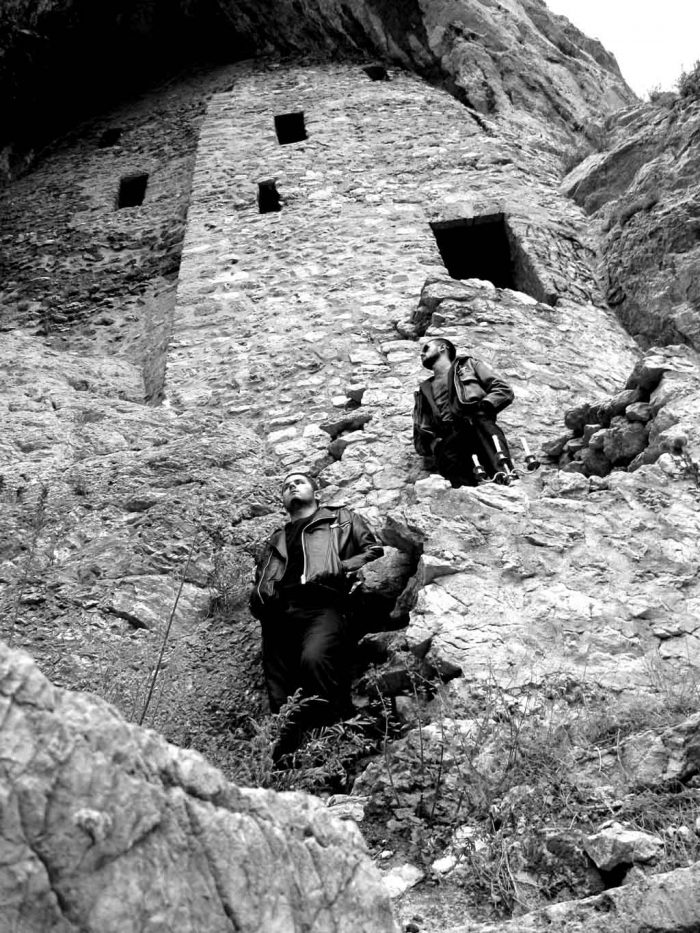
We reviewed Zloslut in our latest Oration of Disorder reviews. Response was good, and so we wrote to the band and asked if they’d do an interview. Hunter of Zloslut was good enough to respond and create this interview.
What does “Zloslut” mean? Why did you choose this name?
Zloslut is a Serbian word that means “The one who feels evil coming”; the translation in English is “Ominous.” This word simply best describes our music, lyrics and state of mind.
When did Zloslut form? Did you face any opposition from the society
around you?
Zloslut made its debut during 2010 in Serbia as a one man band; last year we turned into a real band. No, we did not face any opposition with society, except humanity in general.
What makes the members of Zloslut choose to play black metal music? Wouldn’t you rather make post-metal and sell lots of albums?
We didn’t chose what we are going to play, and create… We just wanted to play music that best fits our ideas. And it is black metal.
Selling a lot of albums is not my purpose. If it would be, then yeah, I would play post metal, haha.
How many releases do you have so far? Can you tell us what is different about Zloslutni Horizont – Donosilac Prokletstva, Ocaja I Smrti?
From our inception through the present day we have made a solid discography, including a demo, split, EP, compilation, an album and several singles.
The different thing about Zloslutni Horizont – Donosilac Prokletstva, Ocaja I Smrti is that it is simple; it’s our zenith. We have advanced ideologically and also musically.
Is this latest album a concept album? If so, what’s it about?
Yes, it is a conceptual album… The strangest thing is that I don’t like conceptual stories… But it turned like that from itself.
The main pillar of the album is death and its philosophies, the second is misanthropy and its spiritual effect, and the last one is more like a question about nothingness.
Where can people in the US and the rest of Europe hear this album? Are there places in EU and US where they can buy Zloslut albums?
Since people today are more and more ignoring phisical releases, I decided to upload the whole album on YouTube, and several tracks on bandcamp and myspace. All of our releases are of course available physically, and can be purchased on our official website.
There are several labels and distros that hold some of our releases, but it’s been a while since i was in contact with them. Currently I am working with distros all over the globe, and in the months to come you can expect to see Zloslut releases in the lists. Until then you can order from me.
You sing in your native language. Why did you choose to do this?
I think that every band should sing on their native language.
But you know, it also depends on the ideology… Some texts are better fitting in English.
I personally didn’t choose that. I have some texts from my demo that are in English and also in French.
Some of my new tracks that will appear in the future are not all in Serbian.
How do you define black metal?
For me black metal is surely not to be close-minded as many of them today are, especially the new trend of Watain wannabe.
Personally, I am a very open minded person when it comes to music, books and so on…
We all know that religious people are close-minded, stopped from following their heart… Because of what? It’s not the question now.
We also all know that in the beginning of black metal, it was an opposition to all kind of religion, political direction etc…
So, to come to the point, black metal is not stopped from following the heart, black metal was always open minded, even when there is something that doesn’t fit its inner direction.
What is being open minded? Certainly not to like and support at once whatever you see, hear and feel… But its to consider what you don’t know or see the first time, analysed it, and then you know what is your personal definition on that subject.
I am not selling education about black metal, but only what I can say… Black metal has been dead for some time now… We might play it, but it’s only a massive tribute to that cult. Maybe one day it will be resurrected, but that I can’t tell you.
What is the process of songwriting in Zloslut? Do you start with an idea, or just play and see what happens? Or something in between?
I don’t have a special way of working. Sometimes I can take a guitar at a party, play it, and accidentally I come to an interesting riff, melody…
And when I make a song, I assemble them, piece by piece, just like puzzles… Until I come to something that may reflect to a song.
What’s next for you — will you tour, release more music, or change style?
2014 will surely be a year of concerts… We have been confirmed so far only in Serbia, but we are still persistent to cross the border and play some European dates. (Promoters get in touch!)
When it comes to releases, we have finished 95% of the second album. When this is going to be recorded/released, is still far away in my mind, maybe middle of 2015… We are also working on a split release where we will contribute with one completely new song. I can’t tell more for now, since we can never see our next obstacle.
6 CommentsTags: Black Metal, interview, zloslut

